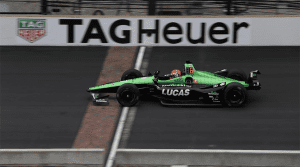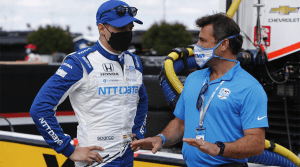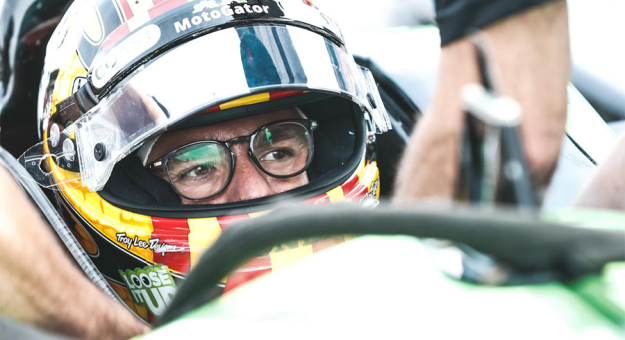The name Oriol Servia is familiar within the Indy car racing community.
Since his maiden Indy Lights season in 1998, the Spaniard has been roaming the IndyCar Series paddock for decades.
Despite his last Indianapolis 500 start coming in 2019, Servia remains immersed in the sport.
As IndyCar’s pace car driver, Servia leads the field to the green flag and during caution periods.
“I love it. People ask me, ‘Do you enjoy driving the pace car?’ I do and I don’t in the sense like it’s a job that you only hear about the pace car when there’s some sort of a screw up,” Servia told SPEED SPORT. “It’s the typical job that no one notices unless it goes wrong.
“I can promise you it can go wrong easier than people realize from the outside. I don’t have much to do, I try to bring as much to the table as possible, not just to driving the car, but the whole safety program and whatever I can contribute to IndyCar.”
For 48-year-old Servia, the open-wheel series has been a home, one he relishes daily.
“It’s a sport that not only I love, but I’ve grown up with,” Servia said. “I’ve been here since 1998, I did Indy Lights for two years and then all my grown-up life has been around the IndyCar paddock.
“Like it or not, I know more than I probably ever thought I would about what’s going on in the paddock, and I love it. Anything I can do to help the series, I like it.
“I think IndyCar still puts out the best racing product there is in the world,” Servia added. “I do feel proud in a way to be part of that of the machine in a different way than I did when I was a race car driver.”
If Servia has his way, his days in an Indy car cockpit aren’t over yet.
Servia is currently seeking potential rides for the 107th running of the Indianapolis 500.

“My work though is finding a good Indy 500 seat that can give me a shot at winning that race, so that’s my focus,” Servia said.
While IndyCar’s popularity and car count has been on the rise, it’s been a bumpy road for Servia to secure a ride.
“Where things stand, it’s hard. It’s hard because IndyCar is in a good, healthy moment right now, where you have 27 cars running full time,” Servia said. “So when you only had 20 cars running full time and the Indy 500 always has 33 cars, then good teams would run two cars the whole season, they would add a third car for the 500.
“So as a one-race guy like myself, there were four or five good teams that could offer you a good speed for the 500. But now those seats are gone, because they’re already doing the full season.”
Before committing to racing as a full-time career, Servia earned a degree in mechanical engineering with a different view on motorsports.
Servia’s father Salvador was a large influence on his son’s racing future, with an immense background in rally racing.
“Until 1999, I saw racing as a hobby,” Servia said. “I grew up in a home that my dad was a Spanish rally champion. But he did it as a hobby. He had a 9-5 job. The reason I have a mechanical engineering degree is because my parents made me study in order for them to support me racing go-karts when I started.
“In my head, I always thought, ‘Hey, racing is great, it’ll be my hobby, I need to make a living doing something else.’ Then, I came here in 1999. Halfway through the year I’m like, ‘Hey, I have a shot at winning this thing and wait a second, whoever wins Lights usually makes it up to IndyCar and they make a living out of this. Wait a second. This is amazing.’”
Thus, Servia’s career was kick-started after scoring the 1999 Indy Lights title by 14 points over eventual NASCAR driver Casey Mears.
While Servia vaulted through IndyCar’s ladder system, each step was a transition period, with each race car adding more horsepower.
“From go-karts, to Formula Renault, to Formula Three, to Indy Lights, each step usually is kind of like double the horsepower, more or less,” Servia said.
However, the jump from Indy Lights to driving an Indy car stunned Servia.

“You’re imagining what it’s going to be and then you drive the car and you’re like, ‘Yeah, but I was kind of hoping or expecting more,’” Servia said. “Then the first time you jumped from an Indy Lights car to an Indy car, I still remember like it’s today that I was like, ‘Holy s—, this is not what I thought, no this is double what I was thinking.’
“It’s kind of funny, like every step up to that point, it’s almost a little disappointing from your expectations. Then the first time I drove the Champ Car at the end of 1999 and early 2000, I was mind blown of the acceleration, not just out of the corners, you can put in gears and it keeps accelerating and then you brake and the thing brakes and you turn and it turns.
“I was like, ‘Wow, this is another dimension.’ Honestly, those two things were a massive change, at least for me. One, realizing, ‘If you perform you can make a living out of this.’ Two, ‘These machines are truly rocket ships on wheels and they’re amazing to drive. So, enjoy it.’”
Servia would adjust quickly to the nuances of America’s top open-wheel category, beginning in 2000 for team owner Cal Wells.
However, his first victory didn’t come until 2005 in Montreal, during a season that saw him notch seven podium finishes and a second-place effort in points.
More podiums and competitive rides emerged for Servia in a full-time capacity up until 2012, when the Spaniard took a step back.
Servia competed for 14 different IndyCar teams over the course of his career, a number that has gone untouched for better or worse. Along the way, Servia had the unique opportunity to be teammates with some of open-wheel racing’s best drivers.
“One of the reasons I never gave up, is that I was very lucky that I’ve been teammates, through all these cycles with four main guys that have dominated open-wheel racing in this part of the world,” Servia said.
“First was Cristiano da Matta. Then, Sebastien Bourdais and Will Power. I forgot Scott Dixon for three races at PacWest in 2002. So, it actually goes de Matta, Dixon, Bourdais, Power. Arguably the four fastest guys in IndyCar the last two decades.”
The opportunity to work alongside those four drivers, fueled Servia’s desire to compete.
“There are many more talented guys, but these four guys are obviously legends,” Servia said. “I was lucky enough to have them as teammates where I was able to truly compare myself to them on the same team, same equipment, and same story that at least it gave me enough mental fuel to keep pursuing the next challenge.
“I knew what I was. I knew the things I learned. I was lucky to learn from all these guys.”
Follow @DHoffmanMedia22